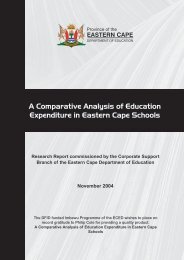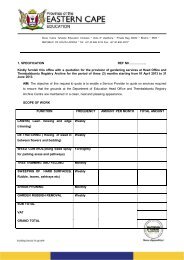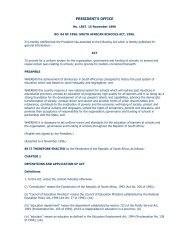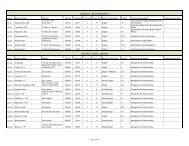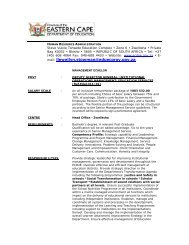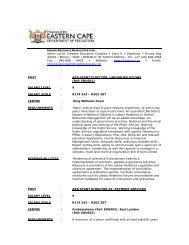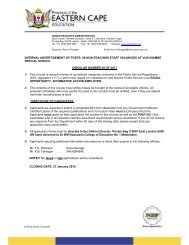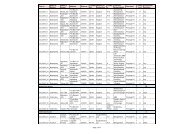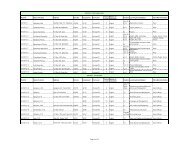part a: strategic overview - Department of Education
part a: strategic overview - Department of Education
part a: strategic overview - Department of Education
Create successful ePaper yourself
Turn your PDF publications into a flip-book with our unique Google optimized e-Paper software.
� Large numbers <strong>of</strong> dependents<br />
� Low levels <strong>of</strong> literacy<br />
� Small proportions <strong>of</strong> the population with tertiary education<br />
� Low levels <strong>of</strong> basic household services such as electricity and piped water<br />
Using this index the most disadvantaged district (see Graph 6) in the Eastern Cape was<br />
Lusikisiki with a score <strong>of</strong> 0.972, followed closely by Dutywa with 0.970 and Bizana with<br />
0.908. Other districts with high relative deprivation index scores were Mt Fletcher,<br />
Libode and Maluti, all <strong>of</strong> which have high proportions <strong>of</strong> 7-18 year olds in relation to their<br />
total populations, and hence many dependents. Poorer districts such as these should be<br />
targeted for greater development assistance and school support.<br />
At the other end <strong>of</strong> the spectrum are the districts <strong>of</strong> Port Elizabeth, Uitenhage, East<br />
London and Grahamstown, which, in comparative terms have much lower deprivation<br />
index scores and could be considered better <strong>of</strong>f. It should however be noted that the<br />
Eastern Cape as a whole is one <strong>of</strong> the poorest provinces in South Africa.<br />
The main winners and losers are shown in Table 29 and 30. The tables show that<br />
Umzimkulu District has improved its overall ranking the most, followed by Libode and<br />
Cradock. In relative provincial terms, these districts improved socio-economically during<br />
the period 1996 to 2001. By contrast, the districts <strong>of</strong> Queenstown and Maluti<br />
experienced a relative decline. In 1996, Queenstown was ranked 20 th in terms <strong>of</strong> district<br />
poverty but by 2001, it had worsened to 16 th position. Similarly, Maluti went from 9 th most<br />
poor to 6 th during the 5-year period. Seven districts remained in the same relative<br />
position.<br />
Graph 6: Comparative Socio-Economic Deprivation by District<br />
Bizana<br />
Butter wor th<br />
C<strong>of</strong> imvaba<br />
Cr adock<br />
East London<br />
Ngcobo<br />
For t Beauf or t<br />
Gr aaf f -Reinet<br />
Gr ahamstown<br />
Dutywa<br />
King Williams Town<br />
Lady Fr er e<br />
Libode<br />
Lusikisiki<br />
Maluti<br />
Mt Fletcher<br />
Mt Fr er e<br />
Por t Elizabeth<br />
Queenstown<br />
Qumbu<br />
Ster kspr uit<br />
Uitenhage<br />
Mthatha<br />
Umzimkulu<br />
Comparative Soc io-Ec onomic Deprivation by District, 2001 Census<br />
0.000 0.200 0.400 0.600 0.800 1.000<br />
0 = Least Po o r, 1 = M o st Po o r<br />
5 Year ECDoE Strategic Plan for 2005-06 2005/06 to 2009-10. 2009/10 March 21 F (4) 2006 Page 65 Page 69




